Food Safety Best Practices: Elderberry Harvest
Estas viendo esta pagina en ingles. Si deseas verla en español, haz presiona aqui.
Introduction
Elderberry (Sambucus nigra) is an emerging commercial crop in California and in other parts of the U.S. with strong market potential and significant opportunity for expanding regional supply. The small,dark blue-purplish fruit is used in syrups, jams, jellies, wines, and other value-added products. Elderberries have high levels of phenolic compounds, many of which function as antioxidants (Uhl et al., 2022; Lee & Finn, 2007; Veberic et al., 2009). As such, there is demand for elderberry as an ingredient, particularly in the health food sector. Due to the presence of cyanogenic glycosides, a class of naturally occurring toxic compounds that can cause gastrointestinal upset when ingested in large quantities, elderberries should not be consumed raw; they are typically dried, frozen, and/or processed into value-added products following harvest (Senica et al., 2017; Sidor and Gramza-Michalowska, 2015).
Western blue elderberry (Sambucus nigra spp. cerulea) is a subspecies within the genus Sambucus that is native to California and other states in the Western United States. Indigenous people were the first tenders of blue elderberry, and they continue to cultivate and gather it for traditional and cultural use in foods, beverages, dyes, and medicines.
While elderberry shrubs comprise part of California’s natural vegetation, farmers and land stewards intentionally include elderberry in hedgerows, strips of typically perennial native plants along field borders, for the purpose of enhancing biodiversity, natural habitat, and carbon storage on farms. Elderberries grown as hedgerows can also serve as a source of farm income when harvested, processed, and sold as a value-added product.
Whether harvesting elderberries from hedgerows, orchard plantings, or non-cultivated elderberry plants, following good food safety guidelines related to harvest, post-harvest and processing is essential for minimizing the risk of contamination and foodborne illness.
This guide outlines best practices and food safety recommendations for harvesting elderberries and elderflowers and is part of our series on Food Safety Best Practices for Elderberry. Other guides in the series include:
- Food Safety Best Practices: Elderberry Post-Harvest Handling
- Food Safety Best Practices: Elderberry Drying
- Food Safety Best Practices: Elderberry Freezing, Storage, and Holding
In these guides, the term “food safety” refers to the conditions and practices intended to prevent or reduce the presence of biological, chemical, and/or physical contaminants resulting in foodborne illnesses.
A note on elderflowers: Like elderberries, elderflowers are also used in value-added products, such as beverages and baked goods. Cyanogenic glycosides produced in elderberries are found in elderflowers as well, though potential toxicity is reduced by heating and processing. The processes for harvesting and handling elderflowers are generally different from those for fruit. While this series of guides primarily focuses on elderberry fruit rather than elderflowers, similar food safety concepts apply.
General Harvest Considerations


Table 1. Considerations for California Elderberry and Elderflower Harvest
|
HARVEST CONSIDERATION |
ELDERBERRIES |
ELDERFLOWERS |
|
Harvest window |
July to early-September,depending on region |
May-July, depending on region |
|
Quality and maturity indicators |
Elderberries are free from injury and decay, uniformly colored and glossy in appearance (Figure 1). A dusty white bloom forms on the elderberries and elderberries can be harvested as the white bloom fades. Elderberries have bright red juice when crushed. |
All or the majority of flowers on cyme have opened (Figure 2). Flowers will start with a creamy yellow color and will turn white as fruit forms. Flowers are over mature and should not be harvested when dropping petals and when a small cluster of berries begins to form. Turn the flowerhead over to see if fruit has started to form in the back. |
|
Time of day to harvest |
Coolest part of day |
Coolest part of day |
|
Post-harvest cooling |
Cool elderberries by placing harvest bins in shade, followed by refrigeration for a short time (1-3 days at most). |
Remove from the field to an environment free from heat and moisture. Introducing moisture during cooling will impede the drying process. |
Good Agricultural Practices
Good Agricultural Practices (GAPs) are a set of recommended best management practices that can help reduce the risk of physical, chemical, and biological contamination of fresh produce during growing, harvesting, packing, and transport. Broadly, GAPs outline basic requirements related to water, manure, worker health and hygiene, facilities, field sanitation, packing facility sanitation, and transportation (FDA, 1998). Although GAPs are voluntary, some buyers, typically grocery and wholesale, may require the farms they source from to obtain GAP certification by undergoing a third-party GAP audit. While the application of GAPs may vary due to differing harvest settings such as orchard cropping systems, on-farm hedgerows, or non-cultivated places, GAPs are an important mechanism to minimize foodborne illness, which can be caused by pathogens contaminating fresh fruits and vegetables. Below is a list of GAPs we recommend implementing during the elderberry and elderflower harvest process. Each practice should be documented in a Standard Operating Procedure (SOP), a set of instructions for conducting operational tasks on a farm. Guidance on how to create SOPs, SOP templates, and example logs used for farm food safety recordkeeping can be found on the Community Alliance with Family Farmers’ Food Safety Plan Templates webpage.
Health and Hygiene
- Use potable water for Potable water must meet the EPA drinking water standard with zero generic Escherichia coli (E. coli) per 100 mL of water.
- Wash hands thoroughly:
- Before starting work
- Before and after using the toilet
- Before handling or touching any food contact surface – equipment and tools directly contacting the elderberries and elderflowers such as harvest totes, tote liners, scissors, hand pruners and harvest knives
- Before handling elderberries or elderflowers
- After eating, smoking, coughing or sneezing
- Any time hands are visibly soiled
- Ill workers should abstain from handling elderberries and elderflowers.
Cleaning and Sanitation
Cleaning and sanitizing are essential to reduce the risk of biological contamination on the farm!
- Clean and sanitize harvesting tools and equipment (e.g., harvest containers, clippers, knives, scissors, hand tools, buckets, and lids) prior to use.
- If harvesting from various areas around the farm or property, pause the harvest and clean and sanitize harvest tools and equipment as you transition between separate areas. This “clean break” helps distinguish between products in case of a recall. See Clean breaks: building traceability into your elderberry harvest (sidebar) for an explanation of how a clean break fits into a traceability plan.
Animal Intrusions
- Inspect elderberries and elderflowers to ensure there is no visible animal fecal matter on the product prior to harvest.
- If fecal matter is present, flag the area to signal a no-harvest buffer zone. Elderberries or elderflowers with visible fecalmatter on them must not be harvested as fecal matter cannot be safely washed off a crop. An SOP addressing animal intrusions should establish a policy identifying the size of the no-harvest buffer zone, so harvesters know how much space to leave between fecal-contaminated crops and crops that can be safely harvested.
Soil
- Do not harvest elderberries or elderflowers that have fallen on the ground.
- Keep harvest containers off the ground by using a barrier between the ground and the harvest container (e.g., a piece of clean cardboard or an additional container not being used for harvest).
Harvest and Post-Harvest Water
- Harvest and post-harvest water fall under the definition of “agricultural water,” and include water used for harvesting, cleaning and sanitation of harvest equipment, cooling, and handwashing.
- Harvest and post-harvest water must meet the EPA drinking water standard, no detectable generic Escherichia coli (E. coli) per 100 mL. Test water several times a year and keep the results on file.
You can also view or download this information as a PDF document; click here for the Food Safety Best Practices: Elderberry Harvest guide.
Clean Breaks: Building Traceability
into Your Elderberry Harvest
What?
A clean break is a pause in the harvest process during which all direct food contact surfaces are fully cleaned and sanitized (and these actions are documented). All product that is harvested and handled between each clean break is defined as a “lot.” If you harvest a relatively small volume of elderberries from only one or two proximate locations, you may only have one lot of elderberries for each harvest day. However, if you harvest a larger volume of elderberries from different fields or locations, you may choose to build clean breaks into your harvesting process in order to distinguish between different harvest areas. This way, if contamination occurs in one of the lots, the other lots of elderberries would not be affected.
Why?
Clean breaks help you define one lot of elderberries from another. In the event of a recall, the recall would include all harvested elderberries from the last documented cleaning and sanitizing action, forward. Failure to establish clean breaks can lead to expanded recalls in the event a recall becomes required.
How?
Keep detailed records of the cleaning and sanitizing process (what, when, and how) and link these records to specific lots of products. Use a lot code to identify the harvest date, location of harvest, and name of the product. For information about creating a lot code, we recommend: Developing Traceability for Produce Growers.
Who?
Implementing clean breaks helps isolate contamination if it occurs and is a best practice for anyone distributing food products. If you are covered by the Food Safety Modernization Act (FSMA) Produce Safety Rule and must comply with the farm food safety standards written in the regulation, you are required to develop a traceability plan. A traceability plan describes the procedures your operation has in place to identify the origin of potentially contaminated product and where it was distributed. Clean breaks are an important component of a traceability plan.
Traceability Systems
By implementing a traceability system that tracks elderberries from production to consumption, harvesters can quickly respond to a potential recall of contaminated products. Traceability means understanding one step back and one step forward – the field your elderberry was harvested from and where it was sold. With proper traceability procedures, including farm site/block maps, harvest date, and identification of where the elderberries are sold, harvesters can track and potentially limit the amount of produce implicated in a recall. For a sample traceability policy, view the Food Safety Plan Templates page on the Community Alliance with Family Farmers website. An example of a label containing basic traceability information that should be used when selling elderberries or elderflowers is shown below.

Food Safety Modernization
Act (FSMA) Produce
Safety Rule
The FSMA Produce Safety Rule establishes minimum food safety standards for farms growing, harvesting, packing, and holding fresh produce to prevent biological, physical, and/or chemical contamination and reduce foodborne illness. While GAPs are voluntary, your farm may be required to adhere to the food safety standards set forth by FSMA if you are covered by the rule. Your farm’s status under the Produce Safety Rule (covered,exempt, or qualified exempt) depends on the type of food you grow, total annual sales of your farm, where you sell your food, and who you sell your food to (Hultberg, 2021). If the elderberries you harvest are “intended for commercial processing that adequately reduces pathogens” and accompanied by the necessary written assurances, they will be eligible for exemption from the Produce Safety Rule. For more detailed information about the qualified exemption and a flow chart for determining your status from the Food and Drug Administration we recommend Standards For Produce Safety: Coverage and Exemptions/Exclusions for 21 PART 112.
Harvesting Elderberries: Step-By-Step Food Safety Best Practices
How do GAPs apply to your farm? Harvesters should take GAPs-aligned steps to minimize food safety risks during harvest. Below we summarize a step-by-step process for harvesting elderberries using appropriate food safety guidelines:
- Begin by washing your hands (Figure 4), following this step-by-step process:
- Rinse hands with potable water.
- Apply liquid soap.
- Scrub for 20 seconds.
- Rinse hands with potable water.
- Dry hands with a single use paper towel or reusable towel that will be used once and then washed.
- If using a paper towel, dispose in a covered bucket or trash can. If it is necessary to lift the lid, use the towel to avoid recontaminating your hands.
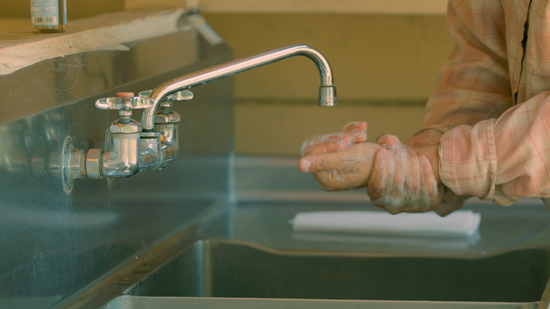 Figure 4. Before harvesting elderberries and/or elderflowers, wash your hands thoroughly to minimize the risk of contamination. Ethan Ireland.
Figure 4. Before harvesting elderberries and/or elderflowers, wash your hands thoroughly to minimize the risk of contamination. Ethan Ireland.
- Next, clean and sanitize your elderberry harvest tools (hand pruners, harvest totes, etc.). For cleaning and sanitizing, harvest tools should be elevated off the ground (placed on a sanitized plastic pallet, cart, or crate). Follow this 4-step process:
- Pre-rinse by removing large particulate matter such as field soil, plant materials, and debris.
- Wash and scrub by applying detergent to harvest equipment.
- Rinse harvest equipment with clean water to clear away detergent and remaining soil.
- Sanitize harvest equipment. Choose a sanitizer that is labeled for use on food contact surfaces. If the label on the bottle does not include this information, look up the EPA registration number (which is listed on the label) and determine if the sanitizer is suitable for use on food contact surfaces. You must mix and apply the sanitizer according to the instructions on the label. For more information about selecting the appropriate sanitizer, we recommend the following resources from the Produce Safety Alliance:
- With clean hands and harvest equipment, inspect the elderberry harvest area for any visible animal fecal matter before harvesting (Figure 5). Birds and deer are common animals affecting elderberries with their fecal matter.
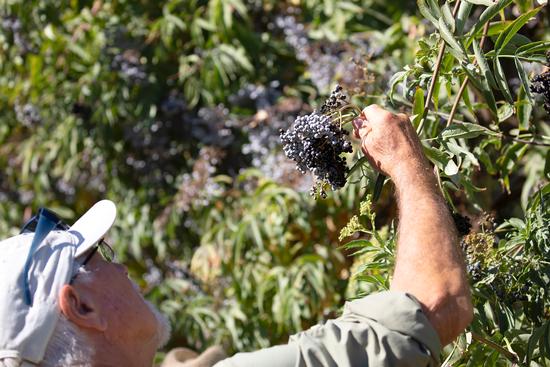 Figure 5. Elderberry harvest areas should be inspected for any signs of animal intrusion or animal fecal matter before harvest. Evett Kilmartin.
Figure 5. Elderberry harvest areas should be inspected for any signs of animal intrusion or animal fecal matter before harvest. Evett Kilmartin. - If you find animal fecal matter on an elderberry umbel, put on disposable gloves, and carefully mark the spot with a bright-colored ribbon (Figure 6). The ribbon signals not to harvest within a reasonable distance (i.e., the no-harvest buffer zone) from the fecal matter to minimize the risk of contamination. Alternatively, affected elderberries and elderflowers should be disposed of in the trash to reduce the risk of cross- contamination. All farm employees who harvest should be trained to monitor, identify and address fruit contaminated by animal feces. It is important to wash hands and/or remove gloves, tools, or potentially contaminated clothing immediately after handling or coming into contact with any animal feces.
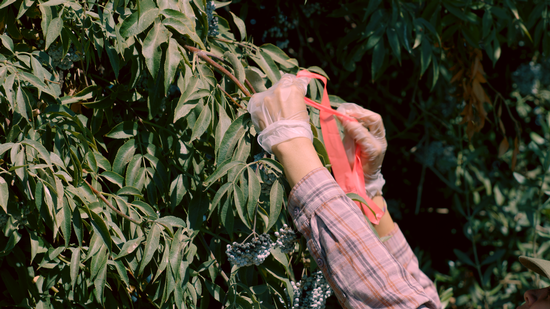 Figure 6. Elderberries or elderflowers contaminated with visible animal fecal matter should be flagged to avoid harvesting this area. Ethan Ireland.
Figure 6. Elderberries or elderflowers contaminated with visible animal fecal matter should be flagged to avoid harvesting this area. Ethan Ireland. - Once the animal intrusion inspection has been completed, you can start harvesting elderberries. Support the berry cluster with one hand and clip at the stem with the other (Figure 7).
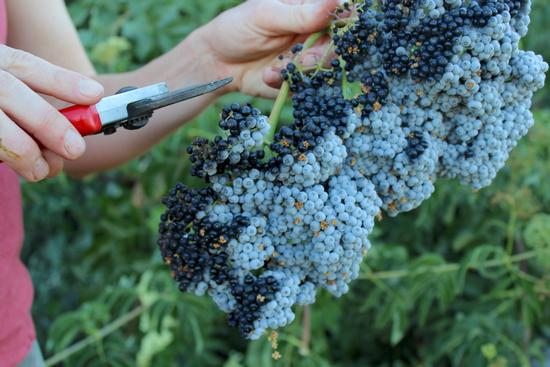 Figure 7. To harvest elderberries, gently support the cluster with one hand while clipping the stem with the other. UC SAREP.
Figure 7. To harvest elderberries, gently support the cluster with one hand while clipping the stem with the other. UC SAREP. - To avoid possible contamination from the soil, exclude from harvest any elderberry clusters on or touching the ground, and any clusters dropped on the ground during harvest (Figure 8).
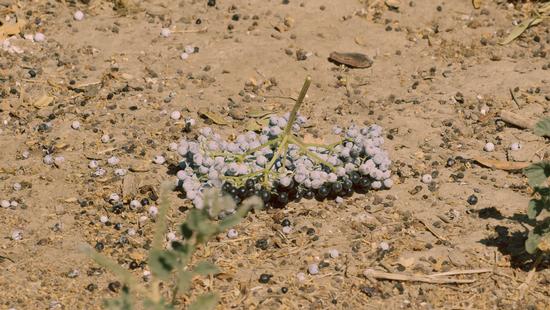 Figure 8. Do not harvest berries that are on or touching the ground as they can cause cross-contamination from the soil. Ethan Ireland.
Figure 8. Do not harvest berries that are on or touching the ground as they can cause cross-contamination from the soil. Ethan Ireland. - Use a separate container as a barrier between the ground and the tote with the harvested elderberries (Figure 9). When full, keep this tote in a cool, shady place or transfer directly to a cooler.
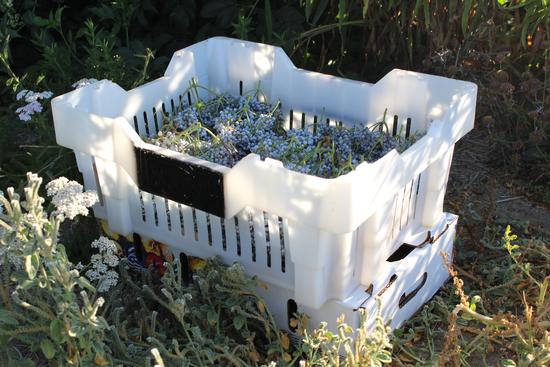 Figure 9. To avoid cross contamination of elderberries or elderflowers, use a separate container as a barrier between the ground and totes. UC SAREP.
Figure 9. To avoid cross contamination of elderberries or elderflowers, use a separate container as a barrier between the ground and totes. UC SAREP. - Before moving to a different location on the farm to harvest elderberries, you may wish to take a clean break (see Clean breaks: building traceability into your elderberry harvest in the sidebar).
- Now you have completed the harvest, and you are ready for post-harvest processing!
Note: It is best practice to establish SOPs and keep records of these processes as part of your food safety plan. For more information about SOP samples and templates, refer to the Resources section at the end of this document.
Conclusion
With its functionality as both a provider of environmental benefits and use as an ingredient in value-added consumable products, Western blue elderberry is a valuable plant to integrate into farm and native landscapes to aid in habitat and enterprise diversification. Harvesters of elderberries and elderflowers should follow GAPs in order to minimize food safety risks and prevent foodborne illness. Following basic steps for food safety best practices when harvesting can help both minimize the risk of food contamination and preserve the quality of the elderberries and elderflowers so that a safe, quality product can be developed down the line. To learn about next steps for food-safe handling of elderberries and elderflowers, read the next guide in the series, Food Safety Best Practices: Elderberry Post-Harvest Handling.
Resources
ELDERBERRY INFORMATION & BEST PRACTICES
California Elderberries: Harvesting, Processing & Marketing. University of California Sustainable Agriculture Research and Education Program (UC SAREP), UC Agriculture and Natural Resources.
FOOD SAFETY TEMPLATES
Farm and Packinghouse Record Keeping Sheets. Cornell College of Agriculture and Life Sciences.
Farm Food Safety Planning: Plan templates and log sheets. University of Minnesota Extension.
Food Safety Plan Templates. Community Alliance with Family Farmers.
PRODUCE FOOD SAFETY COMPLIANCE
Good Agricultural Practices Basics. University of Minnesota Extension.
Standards For Produce Safety: Coverage and Exemptions/Exclusions for 21 PART 112. U.S. Food and Drug Administration.
Developing Traceability for Produce Growers. Kansas State University Research and Extension.
SANITIZERS
Introduction to Selecting an EPA-Labeled Sanitizer. Produce Safety Alliance.
Labeled Sanitizers for Produce Tool. Produce Safety Alliance.
References
Food and Drug Administration. (1998). Guidance for industry: guide to minimize microbial food safety hazards for fresh fruits and vegetables.
Hultberg, A. (2021). FSMA and the Produce Safety Rule: Does the rule apply to me? University of Minnesota Extension. Retrieved December 14, 2023.
Lee, J. & Finn, C. E. (2007). Anthocyanins and Other Polyphenolics in American Elderberry (Sambucus Canadensis) and European Elderberry (S. Nigra) Cultivars. Journal of the Science of Food and Agriculture, 87, 2665–2675.
Senica, M., Stampar, F., Veberic, R. & Mikulic-Petkovsek, M. (2017). The higher the better? Differences in phenolics and cyanogenic glycosides in Sambucus nigra leaves, flowers and berries from different altitudes. Journal of the Science of Food and Agriculture, 97, 2623-2632.
Sidor, A. & Gramza-Michalowska, A. (2015). Advanced research on the antioxidant and health benefit of elderberry (Sambucus nigra) in food – a review. Journal of Functional Foods, 18B, 941-958.
Uhl, K.R., Fyhrie, K.J., Brodt, S.B., & Mitchell, A.E. (2022). Blue Elderberry (Sambucus nigra ssp. cerulea): A Robust and Underutilized Fruit for Value-Added Products. ACS Food Sci. Technol, 2 (2), 347-358.
Veberic, R., Jakopic, J., Stampar, F., & Schmitzer, V. (2009). European Elderberry (Sambucus Nigra L.) Rich in Sugars, Organic Acids, Anthocyanins and Selected Polyphenols. Food Chemistry, 114 (2), 511–515.
___________
August 2024
Authors: Alicia Baddorf, Gwenaël Engelskirchen, Kristen Farrar (UC Sustainable Agriculture Research & Education Program); Erin DiCaprio, Thais Ramos, Ruofen Liao, Isabella Tosta (University of California Davis Department of Food Science & Technology)
Reviewers: Kali Feiereisel, Community Alliance with Family Farmers; Katie Reneker, Carmel Berry Company; Patrick Byers, University of Missouri Extension
This work was supported in part by the U.S. Department of Agriculture, National Institute of Food and Agriculture, Food Safety Outreach Program (award 2020-70020-33031). The information within has not been formally disseminated by the U.S. Department of Agriculture and should not be construed to represent any agency determination or policy.






